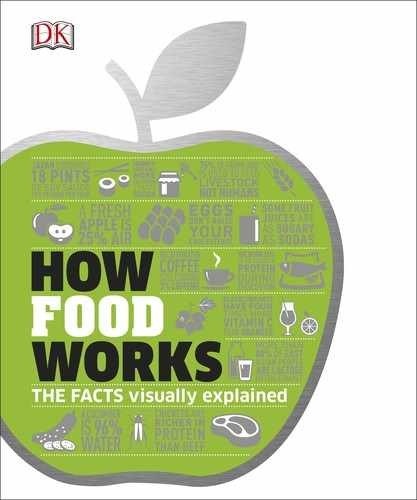
FOOD AND ENVIRONMENT
Feeding the world
YEAR
2006 2008 2010 2012
Meat consumption
per capita
Cereal consumption
per capita
The scale and efficiency of food production has improved
over the past 60 years, due to technological advances, and
in response to a growing population. Some people, however,
still go hungry. Hunger will likely stay with us, as the more
affluent people among the world’s growing population
increasingly gain a taste for meat. Eating meat takes
up a disproportionate amount of Earth’s resources.
Green revolution
In the 1960s and 70s there was widespread concern
about a looming mismatch between food supply and
demand on a global basis in the face of a skyrocketing
global population. Books such as Stanford University
professor Paul Ehrlich’s 1968 best-seller, The Population
Bomb, predicted a looming famine crisis. The success
of the Green Revolution saw a radical increase in
agricultural productivity. Improvements in agricultural
machinery, biotechnological chemicals, and social
collaboration were made that averted the crisis.
Rise in meat consumption
Despite the Green Revolution, we still face food
sustainability challenges—one of which is meat eating.
Global demand for meat has increased five-fold in the
last 50 years. While meat is stable at around 30 percent
of the diet in the West, in some developing countries,
the rate of meat consumption is skyrocketing. Farming
livestock relies heavily on the availability of water, land,
feed, fertilizer, fuel, and waste disposal capacity—and
the pressure on these resources is climbing.
Biotechnologies
High-yield, drought-resistant
hybrid crops and massive
application of fertilizers,
pesticides, herbicides,
and other biochemicals
dramatically increased yields.
Global meat and
cereal consumption
This graph shows a global rise
in total consumption of meat
and cereals to the present day
and projected up to 2020.
Mechanical improvements
Large scale mechanization
of agriculture (such as irrigation
machines) made intensive
farming possible on a vast
scale, boosting yields.
Social plans
Consolidation of small farms into
giant ones, and small businesses
into transnational agribusinesses,
created economies of a global
scale and improved yields.
KEY
Feeding the world
US_228-229_Feeding_the_world.indd 228 18/01/2017 11:14
228
FOOD AND ENVIRONMENT
Feeding the world
229
PERCENT CHANGE SINCE 2006
2014 2016 2018 2020
10
8
6
4
2
0
Efficiency of eating animals
In the US, cows eat livestock feed (grain).
A cow has to consume more than
7kg (15lb) of grain to gain 1kg (2
1
⁄4lb)
in weight, and 1kg of cow converts
to around 400g (14oz) of trimmed,
deboned cuts. Feeding cows grass
is more efficient—but is still far less
efficient than simply eating plants.
Efficiency of eating plants
Comparatively, 7kg (15lb) of grain could
feed about 11 people for a single meal.
Growing grain uses less space, energy,
and labor than farming animals.
GRAIN PRODUCED IN
DEVELOPED COUNTRIES
BEEF STEAK TWO PEOPLE
11 PEOPLE
1kg
1kg
1kg
1kg
1kg
1kg
1kg
1kg
200g
(7oz)
200g
(7oz)
1kg
1kg
1kg
1kg
1kg
1kg
WHAT IS THE
MOST SUSTAINABLE
TYPE OF FOOD?
Probably beans—they add
nitrogen back into soil,
reducing or eliminating the
need for fossil fuel-based
fertilizers, reducing
carbon dioxide
emissions.
Animal feed
Worldwide, animals (mainly cows)
consume an estimated one-third or
more of human grain production. In
developed countries, the proportion
is even higher, at around 70 percent
of grain fed to livestock.
70%
FEEDS
LIVESTOCK
30%
FEEDS
HUMANS
400g (14oz) meat,
or two large steaks
1 meal, 545
calories each
11 people would get
545 calories each
800 MILLION
THE NUMBER OF PEOPLE
IN THE WORLD WHO DO NOT
GET ENOUGH FOOD
7KG (15LB) BAGS OF GRAIN
7KG (15LB) BAGS OF GRAIN
US_228-229_Feeding_the_world.indd 229 23/02/2017 11:28

228
FOOD AND ENVIRONMENT
Feeding the world
229
PERCENT CHANGE SINCE 2006
2014 2016 2018 2020
10
8
6
4
2
0
Efficiency of eating animals
In the US, cows eat livestock feed (grain).
A cow has to consume more than
7kg (15lb) of grain to gain 1kg (2
1
⁄4lb)
in weight, and 1kg of cow converts
to around 400g (14oz) of trimmed,
deboned cuts. Feeding cows grass
is more efficient—but is still far less
efficient than simply eating plants.
Efficiency of eating plants
Comparatively, 7kg (15lb) of grain could
feed about 11 people for a single meal.
Growing grain uses less space, energy,
and labor than farming animals.
GRAIN PRODUCED IN
DEVELOPED COUNTRIES
BEEF STEAK TWO PEOPLE
11 PEOPLE
1kg
1kg
1kg
1kg
1kg
1kg
1kg
1kg
200g
(7oz)
200g
(7oz)
1kg
1kg
1kg
1kg
1kg
1kg
WHAT IS THE
MOST SUSTAINABLE
TYPE OF FOOD?
Probably beans—they add
nitrogen back into soil,
reducing or eliminating the
need for fossil fuel-based
fertilizers, reducing
carbon dioxide
emissions.
Animal feed
Worldwide, animals (mainly cows)
consume an estimated one-third or
more of human grain production. In
developed countries, the proportion
is even higher, at around 70 percent
of grain fed to livestock.
70%
FEEDS
LIVESTOCK
30%
FEEDS
HUMANS
400g (14oz) meat,
or two large steaks
1 meal, 545
calories each
11 people would get
545 calories each
800 MILLION
THE NUMBER OF PEOPLE
IN THE WORLD WHO DO NOT
GET ENOUGH FOOD
7KG (15LB) BAGS OF GRAIN
7KG (15LB) BAGS OF GRAIN
US_228-229_Feeding_the_world.indd 229 23/02/2017 11:28
..................Content has been hidden....................
You can't read the all page of ebook, please click here login for view all page.
